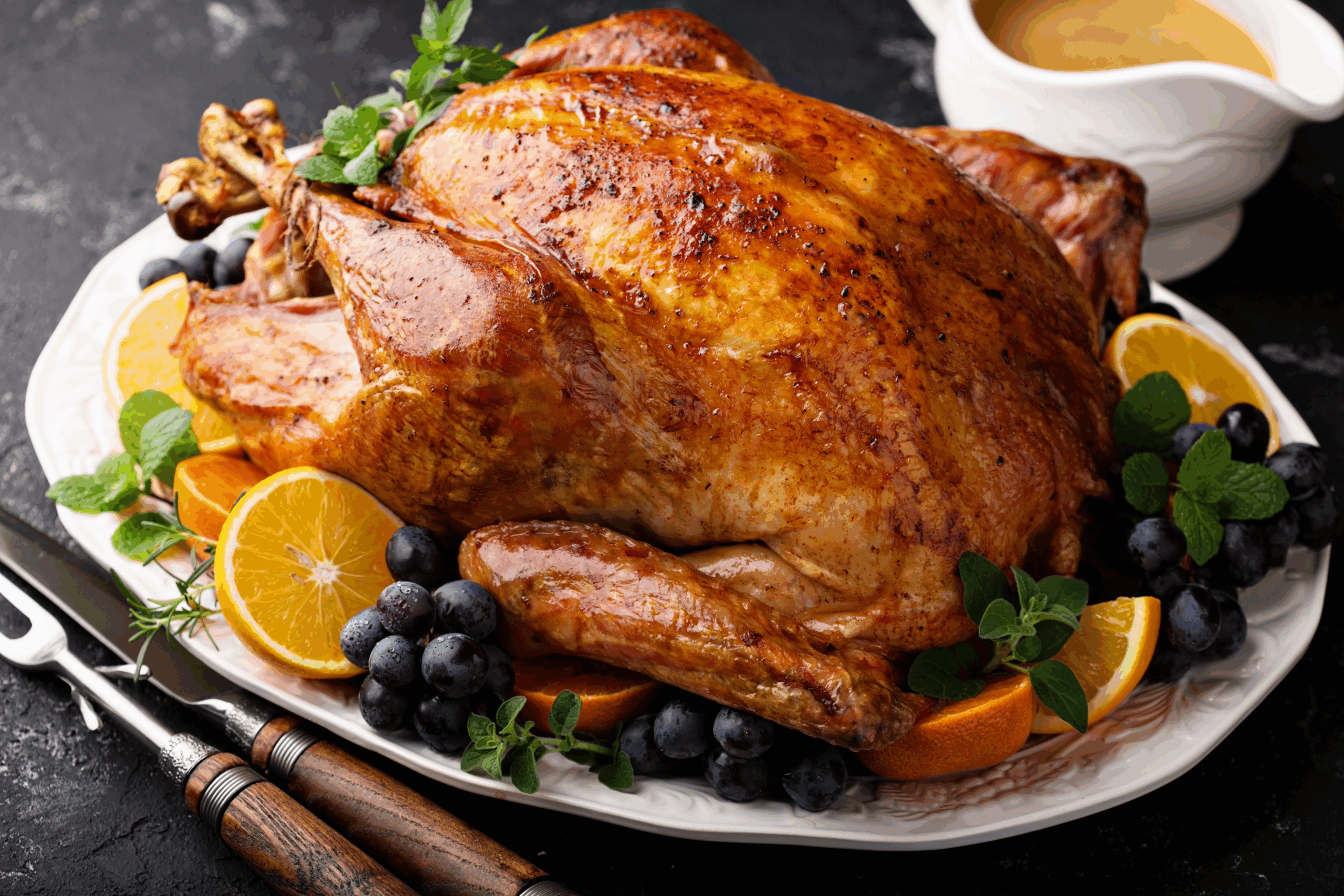As a friendly reminder, I am not a nutritionist or registered dietician. I hold a B.S. in Exercise Science, and have a handful of additional certifications to my name, including the American Council on Exercise’s Health Coach and Precision Nutrition. The knowledge I share, as well as my thoughts and opinions, are from the research I have done over the last 18 years in the industry, as well as through my own education and experiences. I highly recommend you read Catherine Shanahan’s book “Deep Nutrition: Why Your Genes Need Traditional Food.” You will see I cite her book throughout; it is an excellent read that showcases the true meaning of optimal health…and HUGE inspiration for this article! Now back to the matter at hand – Why You Should Be Eating Meat On The Bone?!
It, truly, is the most wonderful time of the year yet it can often feel quite the opposite, especially when it comes to your nutrition. Just like retailers find December to be game changers for their business, this is the time when I hear the most concerns, frustrations, and “I guess I will just start anew come January 1st” from family, friends, and clients. In previous articles, I have shared my health coaching, lifestyle approach and philosophy on nutrition – be your own food “detective,” reframe your mindset from one of scarcity and FOMO to mindfulness and abundance, remember all food is available to you 365 days per year, etc..
While I could continue to dive into my favorite coaching strategies, I wanted this article to focus more on the building blocks of the human, HEALTHY, diet. And, for the record, the human diet is very different from the American diet. I wanted to share the strategies I have researched, implemented, and have found to be nutritional game changers for myself and others. These are strategies you can employ right now, and carry with you into the New Year (and, well, FOREVER)! Catherine Shanahan has coined these strategies as “The Four Pillars of the Human Diet,” and these are the very four I am going to share with you today.
Let’s just say you may not look at a roasted turkey, roasted chicken, or even pot roast the same way again!
Most of the American diet is void of the very ingredients and nutrients that, actually, make them healthy. Cookbooks claiming their pages are filled with recipes of a region’s traditional cuisine are (usually) incorrect. How many modern day diet cookbooks are emphasizing lard as an ingredient? What about the focus of bone-in and skin-on vs. boneless and skinless? Here’s a good one – fat free and low fat vs. full fat? In an effort to create easy meals in minutes, recipes are revised so hard to find ingredients are being swapped with items you can easily find on grocery store shelves, and time consuming cooking methods are drastically altered so you are not spending hours in the kitchen (Shanahan, Catherine. Deep Nutrition. New York. Flatiron Books. May 2018.). Shanahan strives for you to start reframing your mindset, and I would like you to follow suit as well.
- Think less like a chemist, and more like a chef.
- Focus on getting back to our roots, literally! Emphasize ingredients that are as close to the earth as possible, don’t be shy of animal products, and fall in love (or back in love) with cooking traditions that have stood the test of time.
- Look at food differently; think of food as part of our culture & culinary origin.
Strategy #1: Consume Meat on the Bone
Have you ever done a taste test of boneless, skinless meat vs. meat on the bone that has been slow cooked for hours? In my mind there is no comparison at all! The taste alone will always have me reaching for bone-in anyday. Did you know “the more everything stays together – fat, bone, marrow, skin, and other connective tissue – the better” (Shanahan, Catherine. Deep Nutrition. New York. Flatiron Books. May 2018.)? Of course, the better quality of ingredients you start with – i.e. think organic pasture raised – the better the end result too.
- Preserve consistency and texture of your meat – try your best not to overcook. Long story short, when we overcook our meat, not only does the flavor profile cease to exist but it lacks all the beneficial nutrients. Besides it tasting yummy, isn’t this the very reason we are consuming?
- Rekindle your love of the slow cooker. Don’t worry, if you do not have a slow cooker it is perfectly fine; you can achieve the slow cooked method by means of the oven too. Slow cooking is a perfect way to take a meal from really good to outstanding. Just as I mentioned earlier about thinking like a chef, most chef’s will tell you that it takes time for flavors to really release and emerge. This is why slow cooking is so valuable – it gives your meat plenty of time to reach its full potential. “Making sure you are slow roasting with additional parts such as skin and ligaments, you are creating additional nutrition which includes the added benefits of glucosamine, chondroitin sulfate, and hyaluronic acid” (Shanahan, Catherine. Deep Nutrition. New York. Flatiron Books. May 2018.)? This seems like a much better option than all the supplements for hair, skin, nails, and joints, right?
- Don’t be scared to use the fat! Yes, we need it – plain and simple. It is not only a fantastic source of energy but it makes up 30-80% of our cell membranes. And unlike the other energy source – SUGAR- it does not try to become friends with insulin which promotes weight gain (Shanahan, Catherine. Deep Nutrition. New York. Flatiron Books. May 2018.). In order for certain vitamins to be absorbed – A, D, E, and K – we need to consume FAT!
- Bone broth is not just a fad – I feel it is part of the nutritional hierarchy. You are getting the delicious nutrients, marrow, fat, and vitamins that have slowly simmered off the bones. You may already know but it does wonders for your joint health and building strong bones (Shanahan, Catherine. Deep Nutrition. New York. Flatiron Books. May 2018.). If you have any leftovers from a full turkey or chicken this Holiday season, do not discard. Beyond the meat, this is the nutrient showstopper and it’s ready for you to make an amazing broth out of it.
Strategy #2: Eat the Organ Meat
Also known as offal meats – and, I know what you may be thinking but it is not awful – these may be one of the BEST foods you can ever eat. Your grandmother and even great grandmother was absolutely right – you need to eat your liver. While there are lots of various organ meats – and, yes, interesting organ meats to say the least – I am just going to focus on liver. Yes, LIVER.
Incredibly rich in iron, and one of the main nutrients it is touted for, liver is a fantastic source of B Vitamins, Folate, Protein, and Vitamin A. If you are interested in trying, check out The Organic Butcher in McLean or you can order from the online brand US Wellness Meats. Both of these establishments are my favorites, and both are my go-to’s. If you are not 100% sold – trust me, I have not done the traditional liver – start with either a liver pate or sliced beef liverwurst. I pan fry in ghee and consume with my eggs. It’s the new sausage.
Strategy #3: Fermentation + Sprouting = Some of Today’s Best Foods
To keep things simple, fermentation is the awakening of a food, although it may seem completely opposite when you find out it is a process of “controlled rotting.” Sprouting, on the other hand, is the germination of a seed (Shanahan, Catherine. Deep Nutrition. New York. Flatiron Books. May 2018.). Both of these methods are influential on one another; they essentially stop the activation of toxins that make certain plants unsafe for us to eat.
First, let’s talk about fermentation. What’s fascinating is that bacteria can transform compounds that are dangerous, bland, and not digestible and turn them into some of the most nourishing foods you can eat. When we consume foods that contain live cultures – i.e. homemade pickles, homemade sauerkraut, plain yogurt, etc. – “our digestive juices attack and destroy many of the little critters. While many survive and protect us, those that are digested give us all of their nutritious parts” (Shanahan, Catherine. Deep Nutrition. New York. Flatiron Books. May 2018.). Additionally, fermented foods are rich in friendly probiotics, protecting our intestinal tract and working with our immune system to not only keep us healthy but prevent certain diseases and possible allergic disorders (Shanahan, Catherine. Deep Nutrition. New York. Flatiron Books. May 2018.).
Next – sprouting. If you have never tried sprouted bread – Ezekiel Bread is my favorite – I highly recommend you try (FYI: these are found in the freezer section).. The germination of a seed makes it much more nutrient dense since they are designed to not let go of their stored minerals, fats, and proteins over a certain period of time. You can enjoy the tastiness of bread without being worried about consuming the empty calories associated with the rise in obesity and diabetes (Shanahan, Catherine. Deep Nutrition. New York. Flatiron Books. May 2018.).
Strategy #4: Fresh Is Best
I am sure you have seen countless commercials and advertisements showing how you can take a daily capsule or powdered supplement and it will be as though you consumed the recommended amount of fruits and vegetables. In a society where we want everything to be a simple & “easy button,” I cannot stress this enough – fresh will always be the best! Whole, fresh foods contain a wealth of antioxidants. These powerhouses “protect our tissues against oxygen damage by acting like selfless chemical heroes, throwing themselves in the line of fire to protect other chemicals from free radical and oxygen damage” (Shanahan, Catherine. Deep Nutrition. New York. Flatiron Books. May 2018.). While eating cooked greens is still adding a much needed benefit, consuming as much of you can raw, and FRESH, is going to pack in the most nutrients and the most antioxidants. My favorite way to strive for 9 every day – get creative with salads and side dishes!
I hope these strategies have opened up the nutritional lens a bit, and will have you viewing the foods you eat & their cooking methods differently too. And, if you are reading this, and have an upcoming trip to France, you are in for a treat! The French have always been known for their culinary expertise, and most of all their cuisine very much embraces the four strategies I have shared with you today.
Written By: Janine Frank





